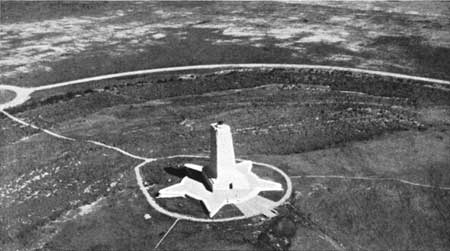MENU
|
Glimpses of Historical Areas East of the Mississippi River |
|
The Recent Era |
|
NORTH CAROLINA |
Special Feature: Site of the first sustained flight by a heavier-than-air machine, made by Wilbur and Orville Wright.

Wright Memorial, Kill Devil Hill Monument.
(Photo by U.S. Army Air Corps)
KILL DEVIL HILL MONUMENT was established in commemoration of the aerial achievement of the two brothers, Wilbur and Orville Wright, who probably contributed more to the development of aviation than any of its other pioneers.
The Wrights went to the sand dunes along the Atlantic, near Kitty Hawk, in northeastern North Carolina, in September 1900 to experiment with gliders. They returned to the spot in the fall of 1901 and again in 1902, and in the following year began to experiment with a power-driven machine, capable of lifting itself. Using a four-cylinder gasoline motor of 12 horsepower, they were able on December 17, 1903, to make four successful flights, the fourth and longest of which lasted 59 seconds and in which their machine developed a speed of 30 miles an hour. Although sustained flights had been made previously by other inventors, notably Samuel P. Langley, who, in 1896, at Washington had catapulted a plane from the roof of a houseboat anchored in the Potomac and had flown it about 3,000 feet, the Wrights were the first experimenters to carry a person from the ground by mechanical means without artificial aids.
In 1927 Congress memorialized the event by setting aside an area in the sand dunes near Kill Devil Hill, and in 1933 a beautiful memorial of white granite was dedicated to the Wright Brothers "In commemoration of the conquest of the air." Appropriately, the shaft is a beacon for both sea-going ships and airplanes.
 Top
Top
Last Modified: Thurs, Nov 23 2000 10:00:00 pm PDT
http://www.cr.nps.gov/history/online_books/glimpses3/glimpses5b.htm
![]()
